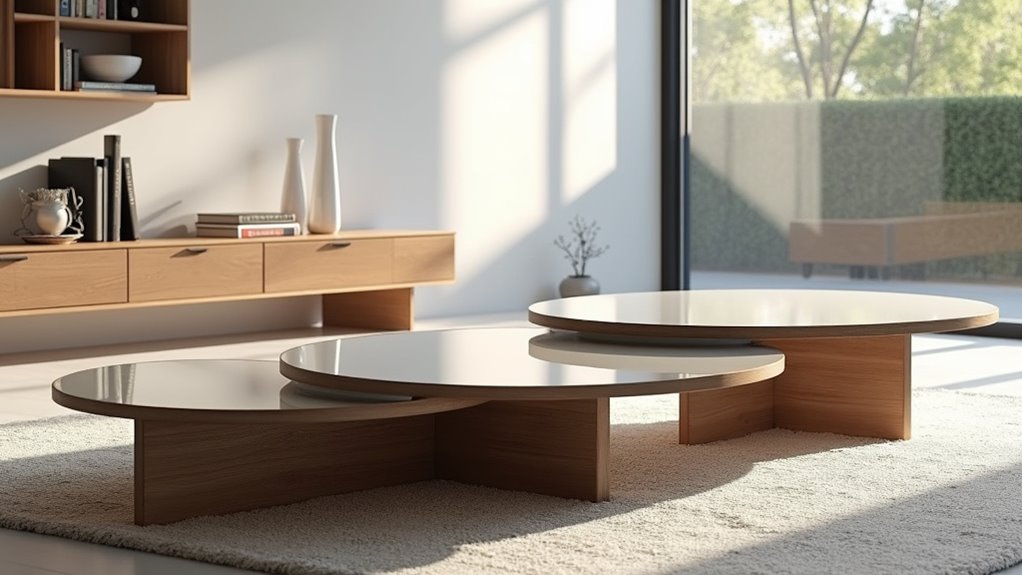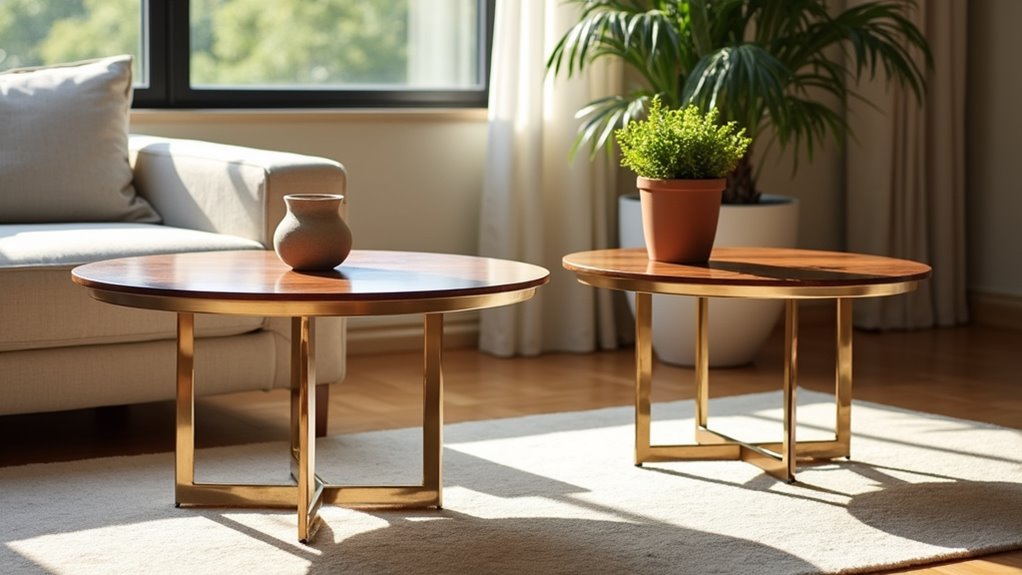To perfectly pair coffee tables and end tables in 2025, start with mixing styles and materials for a unique, eclectic vibe—think modern glass with vintage wood. Next, create harmony by aligning finishes or repeating shapes like circular forms for visual unity. Finally, master scale and proportion by ensuring heights and clearances complement seating dimensions. These methods craft a trendy, polished space. Explore further to uncover additional expert tips for elevating your design game.
Key Takeaways
- Use consistent styles or finishes to create harmony between coffee and end tables.
- Mix materials like glass and wood for a trendy, eclectic contrast.
- Ensure proportional balance with coffee tables 1-2 inches below sofa cushions.
- Coordinate shapes or leg styles for a cohesive, polished look.
- Maintain proper spacing, with 12-18 inches between coffee table and sofa.
Mixing Styles and Materials for a Unique Look

While designing a living space, one can instantly elevate the aesthetic by mixing styles and materials for coffee and end tables, crafting a look that’s both unique and sophisticated.
Eclectic combinations, such as pairing a modern glass coffee table with vintage wooden end tables, inject personality and prevent monotony. This approach thrives on contrast—think sleek metal with warm wood or rustic charm alongside minimalist lines—ensuring pieces feel related yet distinct.
Material fusion is equally transformative, adding depth through intentional contrasts. Combining stone, glass, or brass with varied finishes creates a curated vibe. Infusing personality through varied furniture styles varied furniture styles can further enhance the uniqueness of the space. Drawing from rustic inspirations, incorporating distressed wood and aged metal can add texture and character texture and character to the overall design.
A heavy drum-style coffee table can anchor the space when balanced with airy, legged end tables, while mixing shapes like round and rectangular adds dynamic flair. Unique details, such as carvings or inlays, further elevate the look. This trendy strategy ensures a space feels bespoke, polished, and effortlessly stylish.
Creating Harmony Through Cohesive Elements

Designing a living space with a curated flair often involves shifting focus from bold contrasts to a more unified aesthetic. Achieving cohesive design in 2025 means prioritizing unified elements for a harmonious aesthetics. By aligning coffee and end tables through consistent styles—be it modern or rustic—and coordinating finishes like matching wood stains, one ensures visual unity. Repeating shapes, such as circular forms, and shared details like tapered legs further enhance a balanced look that ties the room together.
To inspire a seamless approach, consider this guide:
| Element | Tip for Harmony |
|---|---|
| Style | Match modern or traditional themes |
| Color/Finish | Use complementary palettes or stains |
| Shape | Repeat curves or geometric lines |
| Design Details | Align leg styles or hardware |
| Material | Pair consistent or complementary textures |
This strategy crafts an effortlessly polished space with enduring appeal.
Mastering Scale and Proportion for Balance

Many interior enthusiasts overlook the critical role of scale and proportion in crafting a balanced living space, yet these elements are essential for both function and flair.
Mastering furniture scaling ensures coffee tables and end tables complement seating, while proportional balance creates a visually cohesive environment. For 2025, precision in dimensions aligns with trendy organic shapes and mixed materials, enhancing perceived scale.
To achieve this equilibrium, consider these expert tips:
- Height Harmony: Set coffee tables 1-2 inches below sofa cushions (16-18 inches standard) and end tables within 2 inches of arm height (18-24 inches) for accessible, balanced design.
- Length and Width Precision: Limit coffee table length to 1/2-2/3 of sofa length, ensuring 12-18 inches clearance, while end table depth matches seating.
- Visual Weight: Distribute furniture evenly, respecting room size and negative space for effortless flow.



Bài viết cùng chủ đề:
7 Stunning Black and Rattan Dining Chairs for Your Home
How to Position a Rug in Your Living Room in 5 Easy Steps
Top 3 Black and White Striped Rugs for Your Home
5 Stunning Black and Gray Wall Decor Ideas for Your Home